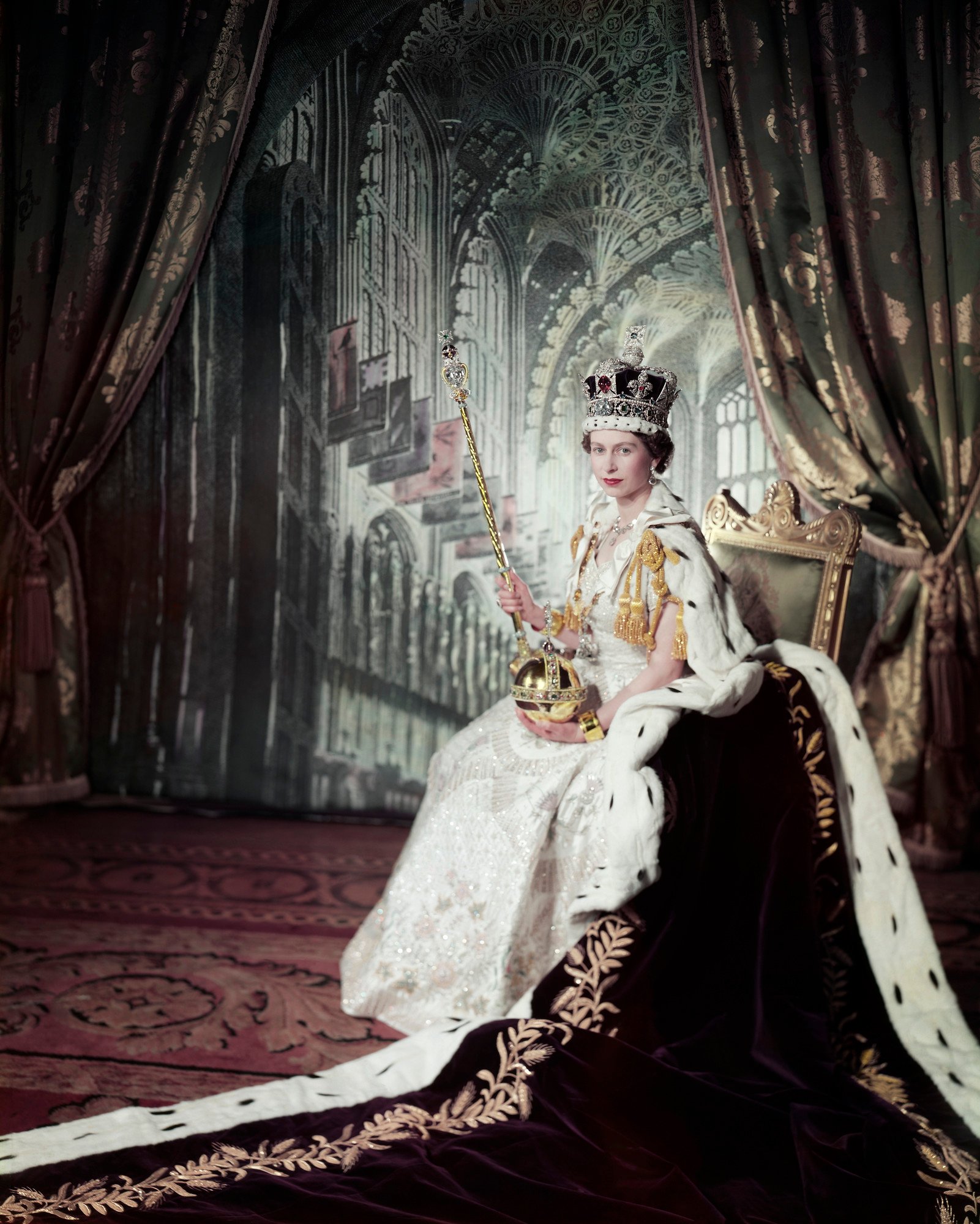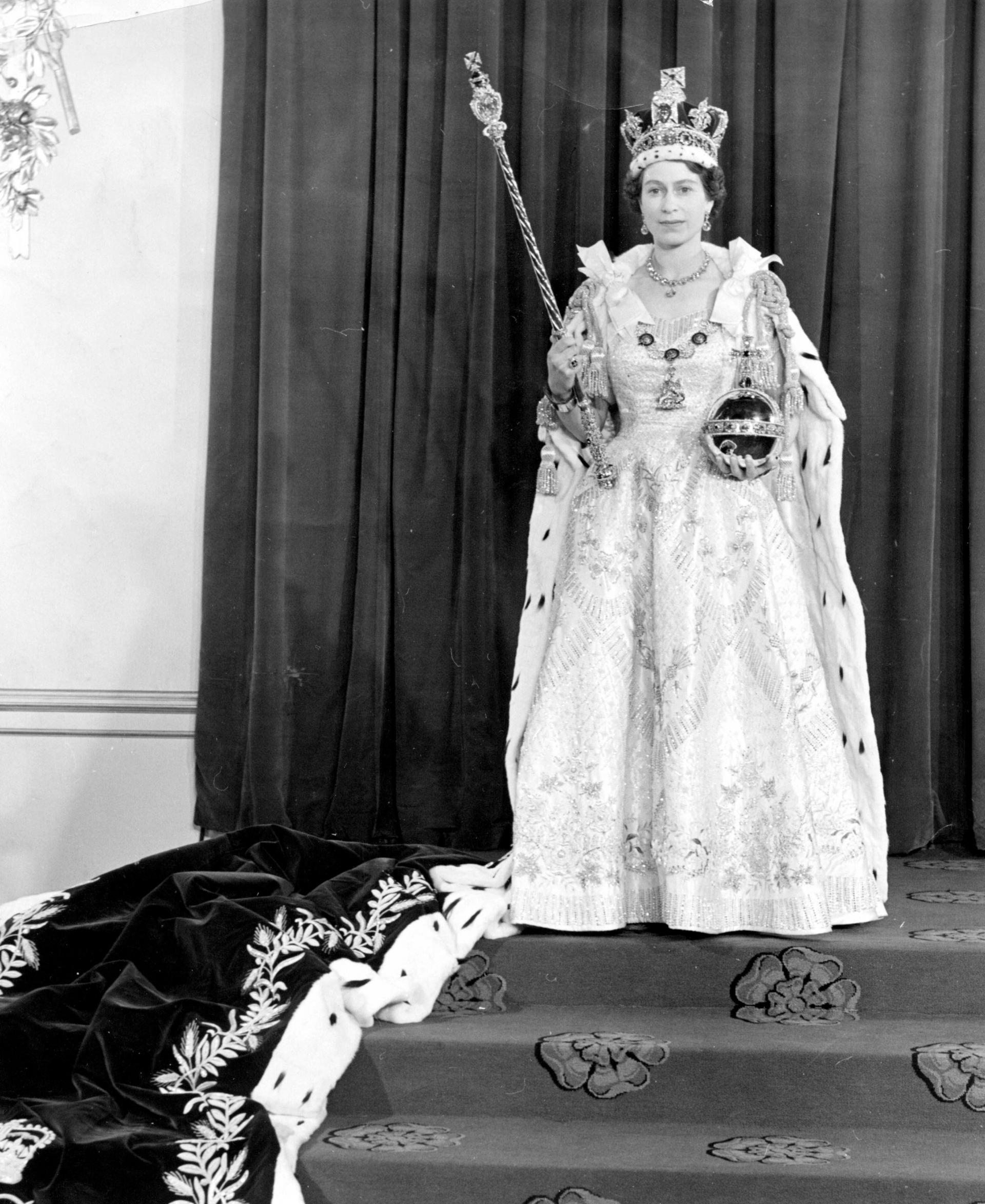|
Supertunica
A Supertunica is a robe worn by British monarchs at their coronation. It is donned shortly after the Anointing ceremony for the vesting of the Crown_Jewels_of_the_United_Kingdom#Spurs, Spurs, Crown_Jewels_of_the_United_Kingdom#Swords, Sword of Offering and the Crown_Jewels_of_the_United_Kingdom#Armills, Armills. Afterwards the Stole Royal and Robe Royal are worn on top of the Supertunica for the crowning of the monarch. The Supertunica, Stole and Robe are replaced with the Imperial Robe for the final procession from Westminster Abbey. Use The monarch enters Westminster Abbey for their coronation wearing the Robe of State. This is removed for the Anointing ceremony in which they wear the ''Colobium sindonis'' ("shroud tunic"), an intentionally plain robe. After the Anointing the monarch dons the more ornate Supertunica over the ''Colobium''. It is worn whilst the monarch is invested with other regalia including the Crown_Jewels_of_the_United_Kingdom#Spurs, Spurs, Crown_Jewel ... [...More Info...] [...Related Items...] OR: [Wikipedia] [Google] [Baidu] |
Stole Royal
The Stole Royal (sometime erroneously called the ''Armilla'') is an item of regalia used during the coronation of a British monarch, similar to the stole (vestment), stoles worn as vestments by clergymen. It is donned after the anointing of the monarch and is worn throughout the crowning, receiving of homage and conclusion of the communion. The Stole Royal is removed, with other garments, before the procession from Westminster Abbey for which the Imperial Robe is worn. Use The monarch enters Westminster Abbey for their coronation wearing the Robe of State. This is removed for the anointing ceremony in which they wear the ('shroud tunic'), an intentionally plain robe. After the anointing the monarch dons the more ornate Supertunica over the . After they have been invested with regalia including the Crown Jewels of the United Kingdom#Spurs, Spurs, Crown Jewels of the United Kingdom#Swords, Sword of Offering and the Crown Jewels of the United Kingdom#Armills, Armills the mo ... [...More Info...] [...Related Items...] OR: [Wikipedia] [Google] [Baidu] |
Robe Royal
The Robe Royal (also known as the ''Pallium Regale'', Imperial Mantle or Dalmatic Robe) is a robe worn by the British monarch when he or she is crowned. It is donned just before the monarch is invested with the Orb, Ring and Sceptres. It is worn during the crowning and paying of homage. The Robe Royal used is one originally created for the 1821 coronation of George IV. Use The monarch enters Westminster Abbey for their coronation wearing the Robe of State. This is removed for the Anointing ceremony in which they wear the '' Colobium sindonis'' ("shroud tunic"), an intentionally plain robe. After the Anointing the monarch dons the more ornate Supertunica over the ''Colobium''. After they have been invested with regalia including the Spurs, Sword of Offering and the Armills the monarch dons the Robe Royal over the top of the Supertunica and also wears the Stole Royal. The monarch is then invested with the Orb, Ring and Sceptres and crowned by the Archbishop of Canter ... [...More Info...] [...Related Items...] OR: [Wikipedia] [Google] [Baidu] |
Crown Jewels Of The United Kingdom
The Crown Jewels of the United Kingdom, originally the Crown Jewels of England, are a collection of royal ceremonial objects kept in the Jewel House at the Tower of London, which include the coronation regalia and vestments worn by British monarchs. The coronation regalia are the only working set in Europe and the collection is the most historically complete of any royal regalia in the world. Objects used at the coronation ceremony variously denote the monarch's roles as head of state of the United Kingdom, Supreme Governor of the Church of England, and head of the British armed forces. The regalia feature heraldic devices and national emblems of England, Scotland, Wales, Northern Ireland, and other Commonwealth countries. Use of regalia by monarchs in England can be traced back to when the country was converted to Christianity in the Early Middle Ages. A permanent set of coronation regalia, once belonging to Edward the Confessor, was established after he was made a saint in ... [...More Info...] [...Related Items...] OR: [Wikipedia] [Google] [Baidu] |
Imperial Robe
The Imperial Robe (also Robe of Estate or Imperial State Robe) is a robe used in the coronation of the British monarch. It is donned in the final stages of the ceremony for the procession of the monarch from Westminster Abbey to the waiting Gold State Coach. These Robes were last seen at the coronation of Charles III and Camilla, with King Charles III wearing the Imperial Robe of George V, and Queen Camilla having a new robe made for her. Use The robe is donned at the end of the coronation when, after being crowned and receiving homage the monarch proceeds to the shrine and tomb of Saint Edward the Confessor. Here the regalia are removed and the Robe Royal and Stole Royal taken off. The monarch is enrobed with the Imperial Robe and processes out of the Abbey whilst wearing the Imperial State Crown and carrying the Orb and Sceptre with Cross. During the coronation the monarch is enrobed by the lord great chamberlain who is assisted by the groom of the robes and the master of ... [...More Info...] [...Related Items...] OR: [Wikipedia] [Google] [Baidu] |
Robe Of State
The Robe of State (also known as the Parliament Robe) is a robe worn by the British monarch on state occasions. A monarch typically has a robe made for their coronation and reuses it when attending the State Opening of Parliament at the start of each legislative session. Traditionally the robes have an ermine cape with a long train made of crimson coloured velvet, trimmed in gold lace and lined with ermine. Use The Robe of State is worn by the monarch for their entrance into Westminster Abbey for their coronation. It is worn subsequently for the State Opening of Parliament and from this association derives its alternative name of Parliament Robe. Recent kings Edward VII, George V and George VI all wore the Cap of State in conjunction with the robe at their coronations but Charles III chose not to do so. The Robe of State remains in place during Recognition, Acclamation, the administering of the Coronation Oath and the first part of the service of Communion. The Robe of ... [...More Info...] [...Related Items...] OR: [Wikipedia] [Google] [Baidu] |
Coronation Of George VI And Elizabeth
The coronation of the British monarch, coronation of George VI and his wife, Queen Elizabeth The Queen Mother, Elizabeth, as King of the United Kingdom, king and List of British royal consorts, queen of the United Kingdom and Commonwealth realm, the Dominions of the Commonwealth of Nations, British Commonwealth, Emperor of India, Emperor and Empress of India took place at Westminster Abbey, London, on Wednesday 12 May 1937. George VI ascended the throne upon the Abdication of Edward VIII, abdication of his brother, Edward VIII, on 11 December 1936, three days before his 41st birthday. Edward's Abandoned coronation of Edward VIII, coronation had been planned for 12 May and it was decided to continue with his brother and sister-in-law's coronation on the same date. Although the music included a range of new anthems and the ceremony underwent some alterations to include the Dominions, it remained a largely conservative affair and closely followed the ceremonial of George V's coronat ... [...More Info...] [...Related Items...] OR: [Wikipedia] [Google] [Baidu] |
Regalia Of King James II First Plate (cropped To Supertunica) (cropped)
Regalia ( ) is the set of emblems, symbols, or paraphernalia indicative of royal status, as well as rights, prerogatives and privileges enjoyed by a sovereign, regardless of title. The word originally referred to the elaborate formal dress and accessories of a sovereign, but now it also refers to any type of elaborate formal dress. The word stems from the Latin substantivation of the adjective ''regalis'', "regal", itself from ''rex'', "king". It is sometimes used in the singular, ''regale''. In the abstract The term can refer to the rights, prerogatives, and privilege (legal ethics), privileges that are held exclusively by any sovereign, regardless of title (emperor, grand duke, etc.). An example of that is the right to mint (coin), mint coins, and especially coins that bear one's own effigy. In many cases, especially in feudal societies and generally weak sovereign state, states, such rights have in time been eroded by grants to, or usurpations by, lesser vassals. Royal ... [...More Info...] [...Related Items...] OR: [Wikipedia] [Google] [Baidu] |





